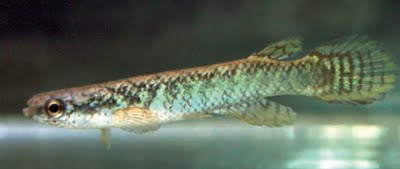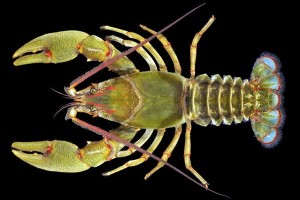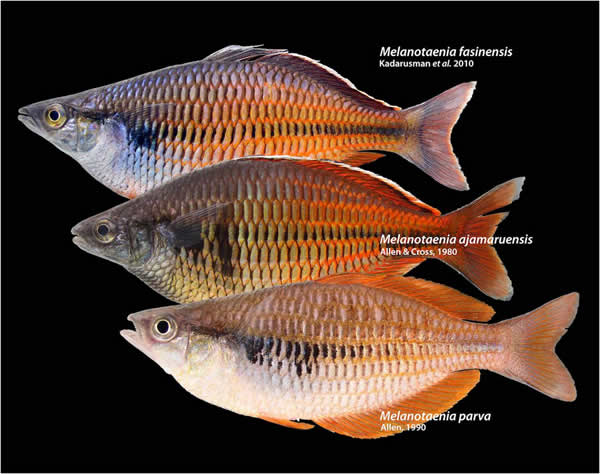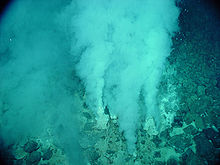Category Archives: New Species
Two species of African Slender-Snouted Crocodile – Mecistops cataphractus
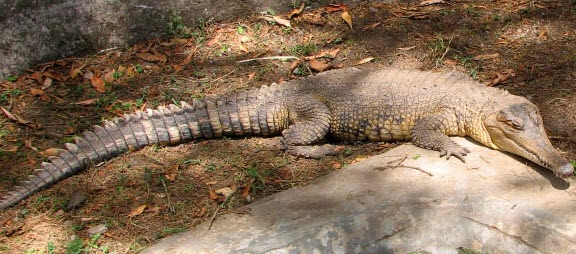
Image credit: Leyo
An international team of researchers from the University of Florida and the SFM Safari Gabon have through DNA Testing discovered that the African Slender-Snouted Crocodile ( Mecistops cataphractus) is actually two different species. Continue reading
New Arapaima species -Arapaima leptosoma – Slender Arapaima

Gold Nugget pleco and Mango pleco finally described by science
Two pleco species from the Xingu River drainage that are popular within the aquarium hobby have finally been scientifically described and given scientific names.
New species of Brazilian killifish described by science
A new species of killifish native to Brazil has been formally described and given a scientific name. The fish, from now on known as Rivulus albae, belongs to the subgenus Melanorivulus and was found in soft and acidic water in northeastern Brazil.
The fish is named after Alba Garcia, the daughter of José Ramón García, one of the authors of the paper in which the species is described.
Appearance
Rivulus albae distinguishes itself from the other members of the subgenus Melanorivulus by having brown oblique bars on the entire flank which on the dorsal portion of the flank often form chevron-like marks with a posterior vertex (vs. chevron-like pattern with vertex pointing anteriorly when present).
Rivulus albae looks quite similar to Rivulus decoratus, but has 6 branchiostegal rays instead of 5, 13 anal fin rays instead of 10 or 11, and 24-26 scales on lateral series instead of 25-28.
Distribution and habitat
All the other recognized species of the subgenus Melanorivulus live in rivers south of the main channel of the Amazon River, but Rivulus albae was collected north of the Amazon River, in the state of Amapá. So far, the species is only known from a handful of localities belonging to Comprido Lake and Tartaruga Grande River.
Rivulus albae was collected in an environment where the savannah meets the forest, close to the banks of large water bodies with clear water at an altitude up to roughly 50 meters above sea level. This fish lives in lakes and lagoons where the underwater vegetation is dense and the water soft and acidic (pH 6.0-6.5).
Authors
- STEFANO VALDESALICI, ITALYvaldesalici.stefano(at)gmail.com
- JOSÉ RAMÓN GARCÍA GIL, SPAIN
- DALTON TAVARES BRESSANE NIELSEN, BRAZIL
The paper was published in Vertebrate Zoology on June 22, 2011.
http://www.vertebrate-zoology.de/vz61-1/06_Vertebrate_Zoology_61-1_Valdesalici.pdf
African Wolf – New wolf Species discovered
This is not really fish related but cool enough to warrant a post here anyway. Scientists have discovered a new species of Wolf in Egypt. A team a researchers from Oxford University’s Wildlife Conservation Research Unit (WildCRU), the University of Oslo, and Addis Ababa University, with funding from the University of Oslo, shows that Gray wolves reached Africa around 3 million years ago before spreading throughout the northern hemisphere. The new wolf is a relative of the Holarctic grey wolf, the Indian wolf and the Himalayan wolf.
The Egyptian jackal (Canis aureus lupaster) is an importan part of the Egyptian mythology and has until now been considered a subspecies of the Golden jackal (Canis aureus) but this new research show that the egyptian jackal is infact a species of wolf. This new species is not closely related to the rare Ethiopian wolves. Ethiopian wolves are a relatively recent of spring from the gray wolf complex while this new species, ”African wolf” (suggested name by Professor Sillero), likely arrived in Africa much earlier.
Professor David Macdonald says: “A wolf in Africa is not only important conservation news, but raises fascinating biological questions about how the new African wolf evolved and lived alongside not only the real golden jackals but also the vanishingly rare Ethiopian wolf, which is a very different species with which the new discovery should not be confused.”
The team also found genetically very similar specimens to this new wolf in the highlands of Ethiopia, 2,500 km from Egypt, suggesting that the new species might have a large distrobution and that it is not just found in Egypt.
The conservational status of this new species is not known.
Professor Sillero says: “It seems as if the Egyptian jackal is urgently set for a name-change, and its unique status as the only member of the grey wolf complex in Africa suggests that it should be re-named ‘the African wolf’.”
WildCRU is part of Oxford University’s Department of Zoology.
If you want to read the entire paper (direct link) you can do so at PlosOne:
New species of giant U.S. crayfish described
‘A species of giant crayfish native to Tennessee in the United States has been scientifically described and given the name Barbicambarus simmonis.
Barbicambarus simmonis can reach a size of at least 5 inches (12,5 cm) which is twice the size of an average North American crayfish.
The researchers behind the paper in which Barbicambarus simmonis was described are Christopher Taylor from University of Illinois at Champaign-Urbana and Guenter Schuster from Eastern Kentucky University.
The first specimen was found by Tennessee Valley Authority scientist Jeffrey Simmons in 2010, and that is why the species bears his name. This specimen, as well as the specimen encountered by Taylor and Schuster, lived in Shoal Creek, a stream in southern Tennessee that ultimately drains into the Tennessee River. The creek has attracted the attention of researchers for at least half a century, which makes it reasonable to assume that Barbicambarus simmonis is either rare or very difficult to find.
You can find out more about Barbicambarus simmonis in the paper “Monotypic no more, a description of a new crayfish of the genus Barbicambarus Hobbs, 1969 (Decapoda: Cambaridae) from the Tennessee River drainage using morphology and molecules” published in the journal Proceedings of the Biological Society of Washington.
Barbicambarus is a genus of freshwater crayfish that up until now had only one member: Barbicambarus cornutus. Barbicambarus cornutus is known only from the Barren River and Green River systems of Tennessee. The largest known specimens are 23 cm (9 inches) long, so this crayfish is even larger than Barbicambarus simmonis and one of the largest species of crayfish in North America*. It was scientifically described in 1884, but not seen again by scientists until the 1960s.
North America is rich in crayfish and also a comparatively well explored part of the world. Of the roughly 600 scientifically described species of crayfish, roughly 50% are native to North America. However, even though North America is such a well surveyed part of the world, new species are regularly described by scientists. The Pearl Map Turtle, Graptemys pearlensis, was for instance described in the summer of 2010. Just like Barbicambarus simmonis, this turtle is native to the southern part of the U.S. It lives in the Pearl River in Louisiana and Mississippi.
New Kind Of Large Squid Making Waves
A brand new kind of large squid has been found by researchers while voyaging around on a research cruise in the southern part of the Indian Ocean.
This large squid, almost a meter long, belongs to the chiroteuthid family.
The squid which form a part of this family are long and thin, and have organs which produce light. The light producing organs help them attract their meals.
This large squid was discovered during an analysis of thousands of different samples which were brought in from the Seamounts cruise last year. The cruise is being led by a conservation group known as IUCN.
The project began a year ago when experts in the area of marine biology set out on a six week science expedition in the Indian Ocean.
The aim of the expedition was to shed some light on the mysterious seamounts – mountains under the water – located in the southern part of the Indian Ocean, and to help manage marine resources and improve conservation plans in the area.
“For 10 days now 21 scientists armed with microscopes have been working through intimidating rows of jars containing fishes, squids, zooplankton and other interesting creatures,” explains a spokesperson of the Department of Zoology at the University of Oxford, Alex Rogers.
“Many specimens look similar to each other and we have to use elaborate morphological features such as muscle orientation and gut length to differentiate between them.”
New Kind Of Fish Discovered
A brand new kind of fish has just been found in one of the dark “lifeless” areas of the ocean. It was previously thought that the area was devoid of fish, researchers say.
This new kind of snailfish was discovered making its home at an amazing depth of 7 kilometers, in the Peru-Chile trench in the South East Pacific.
Large groups of cusk-eels and rather large scavengers were also found making themselves at home at these depths, which is a scientific first, researchers added.
The discoveries, in some of the deepest darkest recesses of our planet, were made by a group of marine biologists hailing from the University of Aberdeen, in conjunction with experts from Japan and New Zealand.
The team set out on a 21 day voyage, during which they made use of various deep-sea imaging equipment to snap photos of the murky depths, some 4500 meters to an astounding 8 kilometers within the trench.
This voyage was the seventh such voyage as part of HADEEP, a research project cooked up by the boys over at the University of Aberdeen’s Ocean Lab and the University of Tokyo’s Ocean Research Institute, along with the backing of New Zealand’s National institute of Water and Atmospheric Research.
The use of the updated technology really gave researchers the boost they needed to discover this amazing find. Who knows what will be dredged up next? Science has been stale for such a long time, especially when you talk about the oceans, so it’s good to see some new discoveries being made right under our noses.
Melanotaenia fasinensis – New Rainbow Fish Named From West Papua
Researchers have just discovered and described a new rainbow fish which hails from West Papua, Indonesia.
Ichthyologists, also known as fish scientists to us normal folk, Paradis, Pouyaud, Kadarusman and Sudarto are credited with the find and have dubbed the new kind of rainbow fish Melanotaenia fasinensis. They published this in a paper in the journal Cybium.
The new rainbow fish was found in the Fasin River, just about 25 clicks west of Lake Ayamaru on the West Papua’s Bird’s Head Peninsula.
The little guy was found floating about in a 1 meter deep, 4.5 meter wide stream, surrounded by flush greenery.
This rainbow fish lives over a substrate of gravel, and makes its home amongst limestone boulders and debris of fallen branches from the forest.
The Fasin River also boasts a myriad of other species such as sleeper gobies, and different types of crayfish.
The Bird’s Head Peninsula in Indonesia is considered a hotspot when one is going about and trying to find rainbow fish. There are many different kinds of rainbow fish which also call the place home, and they all seem to live in harmony with one another.
It’s good to see that the scientific world has not given up on seeking new kinds of this beautiful fish. Not only are they pretty to look at, but they are key to the survival of all the species in that ecosystem.
Some people have been trying to catch them and sell them off as pets, however an ordinance is in place telling people to refrain from such a practice.
Breaking News: New Snail Larval Form discovered: First since 1978!
Well, just when you are comfortable knowing that what you know is accurate, the world comes along and throws you another curve ball. We used to know there were 9 planets, now there are 8, we used to know the earth was the center of the solar system, now we know better.. Now, just when you thought you pretty much knew your basic zoology, an amazing new discovery has been made that is basically going to force some poor guy to rewrite the molluscan, larval ecology and invertebrate text books.
Between the 1850’s and the 1870’s supposedly all known forms of snail were discovered. However, thanks to modern technology, and some persistent researchers, we now know that we were mistaken, and that the forms of snail are really much more diverse than originally thought.
This new snail larval form is really turning heads, and here’s why. This larval form discovered is the first of its kind to be found to be a free-swimming pre-veliger larva. This is rather interesting because normally they don’t swim freely. Not only that but it appears these new little guys can actually turn hydrogen sulfide, and methane as an energy source.. Imagine, a snail which subsists on farts…
Credited with this astounding discovery are Anders Waren, a Swedish Naturalist from the Royal Museum of Natural History in Stockholm, and collegue Philippe Bouchet.
They have been working on this project since the 1980s, and have finally made their marks on history. These are a pair to watch folks, who knows what they might discover next?
